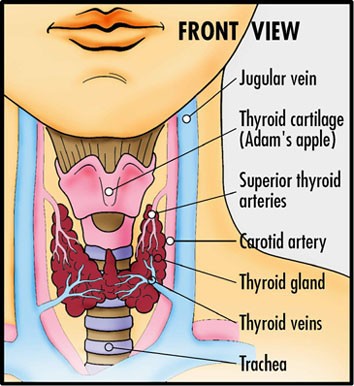Thyroid - Low Function page 1
The Thyroid Gland:
Low Function and Remedies
© 2005 by Nenah Sylver, PhD
PLEASE NOTE: I am not a medical doctor and do not diagnose, treat, or prescribe. This article is designed to provide a brief introductory overview of certain aspects of thyroid function so you can begin to seek out alternatives to what you are already doing. Do not ask me medical questions. For more information, see the resources listed at the end of this article. Consult a doctor if you have a medical problem.

Introduction
The thyroid—a butterfly-shaped gland in the throat with most of its mass on either side of the central Adam’s apple—is absolutely critical to how well we function. Proper thyroid performance is essential for the normal functioning of cells, the nervous system, muscles, brain development, oxygen utilization, the metabolism, and the immune system—to name just several body areas and systems. The thyroid gland regulates all metabolic activity of the body. This means that a person’s growth and development, and the speed and efficiency with which the body takes in nourishment and eliminates waste products, are all under the guidance of the thyroid. It’s easy to see, then, that when the thyroid gland does not function, a person will not feel well. Indeed, some people say that they feel as though their lives are literally falling apart.
The thyroid gland produces a hormone called thyroxin, also known as T4. Thyroxin production depends on a complex feedback loop involving other parts of the endocrine system. The process starts in the hypothalamus, a portion of the brain. The hypothalamus releases TRH (thyrotropin releasing hormone) to stimulate the pituitary gland, located in the brain’s center. The pituitary monitors blood levels of T4 (thyroxin). If there is not enough T4 in the blood, the pituitary secretes TSH (thyroid stimulating hormone) to induce the thyroid gland to produce more T4. When the thyroid produces more T4, the T4 levels in the bloodstream rise. Should the pituitary gland detect too much thyroid hormone in the blood, it decreases production of TSH; so the thyroid is stimulated less to produce T4, and there is less T4 in the bloodstream. In addition to the pituitary and hypothalamus, the thyroid influences and is influenced by other endocrine glands, especially the adrenals, parathyroid, and sex glands.
When the thyroid is sluggish, it is said to be underactive. The medical term for this is hypothyroidism. Sometimes the thyroid can be in a hyperactive or overactive state. The medical term for this is hyperthyroidism. This article, however, will focus on hypothyroidism. Stephen E. Langer and James F. Scheer, authors of the definitive thyroid book, Solved: The Riddle of Illness, state that an amazingly high percentage of Americans suffers from hypothyroidism. Some sources estimate that in the United States alone, nearly 8 million are affected—while according to energetic medicine studies, this is a drastically conservative estimate. Whatever the actual number, it is clear that hypothyroidism is a serious problem in the U.S.
Symptoms of Hypothyroidism
The thyroid is a tiny gland. However, because it governs metabolic functioning, the lack of thyroxin production, or the inability of the tissues to absorb thyroxin, can cause many—and serious—problems. A person need not have all of the following symptoms in order to have an underfunctioning thyroid; but this list will give you an idea of the scope and severity of hypothyroidism. The symptoms include:
allergies
anxiety, depression, irritability, memory problems, mental sluggishness, mood swings, and panic attacks
asthma
blood sugar disorders (diabetes and hypoglycemia)
blood pressure problems (low)
breathing difficulty (shortness of breath with even light walking)
calcium metabolism problems
carbohydrate intolerance
carpal tunnel syndrome
cholesterol levels, high
circulation that’s slow, with resultant cold hands and feet and/or cold or heat intolerance
deafness
digestive disturbances, including constipation, diarrhea, and gas
eyebrows: the outer third of each eyebrow is either sparse, or missing entirely
fatigue (including chronic fatigue syndrome)
fibromyalgia
fluid retention
hair loss and hair brittleness
heart enlargement
heart rate (pulse) slow, even in non-athletes
hoarseness
infections that are recurrent
infertility
insomnia
menstrual problems
muscle and joint aches and pains or weakness
nails that are brittle
skin problems (dry or flaky)
sweating disturbance (lack of)
tumors of all kinds
weight gain
Hypothyroidism Resulting from a Lack of T4
To check for this disorder, doctors customarily test the person’s blood levels of thyroxin (T4). More enlightened doctors will also test for TSH production by the pituitary. People who show low blood levels of T4 are given prescriptions for thyroxin in pill form. The thyroxin pills are in microgram (mcg.) rather than milligram (mg.) amounts because the body doesn’t need much thyroid hormone in order to function. For many years, a medication called Synthroid was prescribed, until it was finally acknowledged by the FDA that it has many “side” effects that harm people. One “side” effect of continual thyroxin supplementation is that the thyroid gland eventually stops functioning completely—because there is no longer any reason for the gland to produce its own thyroxin if the T4 is being supplied by an external source. To remedy this situation, many people are nutritionally boosting their thyroid gland with freeze-dried bovine thyroid gland that has had the thyroxin removed. However, although this can be helpful, as we shall see it’s not the entire answer.
A alternative to Synthroid is the much safer prescription medication called Armour Desiccated Thyroid Hormone. Derived from the thyroid gland of a pig, it resembles the human thyroid gland and contains the entire thyroid tissue. Furthermore, it contains not only T4, but also a related thyroid hormone called liothyronine, known as T3. T3 as a key to thyroid function is discussed in the section below.
Hypothyroidism Resulting from a Lack of T3—Wilson’s Syndrome
Even complex laboratory tests that analyze pituitary output don’t tell the whole story of an underfunctioning thyroid. In the first place, traditional blood tests fail to consider that the adrenals produce small amounts of thyroxin to back up the thyroid when that gland is exhausted. Therefore, blood tests can show sufficient levels of thyroid hormone without indicating where the T4 is being produced. The overworked adrenals might be providing T4—and meanwhile, the thyroid gland is still exhausted!
Second—and pertinent to the theme of this section—most doctors pay attention to levels of thyroxin, or T4, in determining whether or not the thyroid gland is functioning normally. However, liothyronine, or T3, is the more active (though shorter-lasting) thyroid hormone. It is T3, rather than T4, that is absorbed and utilized by the body’s tissues. Within the last decade, a doctor named Denis Wilson discovered that even if T4 blood levels are normal, if the body does not convert the T4 into T3, the person will still be clinically hypothyroid and suffer from all the classic symptoms of hypothyroidism. This condition is called Wilson’s syndrome. Thyroid hormone that remains circulating through the bloodstream is useless if the body cannot absorb and utilize it. Thus, people can have “normal” blood tests and still be hypothyroid. Similarly, if laboratory tests indicate low blood levels of T4 (thyroxin) and the person is given T4 to remedy the situation, the body might still have difficulty converting that T4 into T3 (liothyronine). This is why people with Wilson’s syndrome who receive prescription T4 (in whatever form) don’t improve.
What, than, can be done for many people suffering from hypothyroidism due to the inability of the body to convert T4 to T3? The treatment for Wilson’s syndrome is a time-release T3, available by doctor’s prescription only, and supplied only by compounding pharmacies that specialize in less mainstream medications. The T3 should be in time-release form because the body requires T3 constantly, day and night, and because the thyroid gland is incredibly precise in its timing of hormone output.
So far I have referred only to laboratory tests that check for blood levels of T4 (thyroxin). Why not check for blood levels of T3 (liothyronine)? Doctors who know about Wilson’s Syndrome will sometimes do this, if there is a question about whether the person has Wilson’s (testing for T3 is expensive). However, it’s generally easy enough to tell, from the person’s clinical symptoms—and often, even by how the person looks (it’s easy enough to see split nails, or observe the faint or missing outer third of the eyebrows).
Treatment with T3 is complex. A full explanation is beyond the scope of this article, but see the link to Dr. Wilson’s website at the end of this article for more information.
Body Temperature a Better Indicator than a Blood Test
Measuring body temperature is a foolproof way of determining whether or not the bodily tissues are receiving enough thyroid hormone (for whatever reason). For someone in a hypothyroid state, it is not uncommon for body temperatures, even during the day, to be as low as 96°F (35.6°C). For many people, a typical temperature can hover at 97°F (36.1°C) or 97.5°F (36.4°C). Early morning and late night temperatures fall a bit, but they shouldn’t be that low.
For any type of thyroid problem, Langer and Scheer state that taking one’s temperature before rising, over the course of many days, is a more accurate gauge of thyroid function than conventional (and expensive!) laboratory tests. However, since people’s temperatures are generally lower when first awakening and just before sleep, Dr. Wilson suggests taking the temperature 3 hours after rising, and then twice more during the day, to obtain an average temperature. In addition to being a much more accurate indication of one’s average temperature, it also gives valuable information on the margin of temperature fluctuation. Wild temperature fluctuations indicate that a person’s T3 levels are not steady.
Again, it should be emphasized that if you have any sort of thyroid dysfunction, see a health care practitioner! The medical profession considers this condition too serious and complex to self-treat. Often, other glands are involved. However, there are things that you can do for yourself in the meantime.

Now available as a Hardcover
and in MOST formats!
as a printed/bound hardcover
as a Windows ![]() eBook
eBook
as a Mac eBook
eBook
for Tablets and iPads 
for Android 




